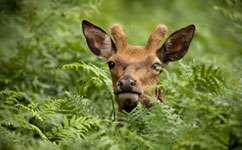Wandering females give stags the slip

The fierce battles of rutting stags may be the most famous symbols of males competing over females in the animal kingdom. But it turns out the stags don't have things all their own way.
They may put their lives on the line to gain and hold onto their own exclusive 'harem' of females, but those females don't necessarily then stay put.
In fact, they often wander off and mate with another suitor, according to a new report in Behavioral Ecology by scientists from the Universities of Edinburgh and Cambridge and from the James Hutton Institute.
A long-term study of the deer of the Isle of Rum shows that 43 per cent of females move to a new harem during their brief period of fertility, and 64 per cent of them have traveled a considerable distance to do so - some as much as 4km.
Some 45 per cent of these so-called 'rut excursions' end in the female being impregnated by the male into whose harem she's moved. These does aren't just strolling about for the fun of it; their trips have important consequences for which males get to pass on their genes.
'It was hugely surprising when we realised how common this behaviour is - we'd assumed it was just a few females making rut excursions, but it turns out it's nearly half of them,' says Dr Katie Stopher of the University of Edinburgh, lead author of the paper. 'And they're moving very substantial distances - the rest of the time they stick closely to their home ranges, so to find some of them four kilometres away is very unusual.'
Yet the researchers still aren't sure why the females do this. Their analysis shows they don't seem to be travelling to mate with a preferred male. They aren't any more likely to move to mate with older males, or with males with bigger harems, or even with males that are less closely related to them - if the evidence had supported it, the latter hypothesis might have suggested their excursions were efforts to avoid the risk of inbreeding.
Stopher says more research is needed to find out exactly what females are getting out of this behaviour - making long cross-country journeys costs a lot of energy, so presumably the females get some benefit or they wouldn't do it. The fact they only go on these excursions during their brief windows of mating opportunity strongly suggests they're connected to mating, and not food, environmental conditions or other more general factors.
She suggests that two possible ideas are that the wandering females are responding to excessive harassment in their original group and looking for a male who can provide better protection from unwanted advances, or for a male they've mated with in previous years.
The first possibility would suggest females would be more likely to move into the harems of bigger males with more impressive antlers, since these features help males win fights and so improve their chances of defending their females against importunate rivals. These males would also be likely to have bigger harems already, though, so if this hypothesis was true one might expect the study might to show that females are likelier to move to such bigger groups, which it didn't.
The second possibility also raises further questions - why would a female want to mate repeatedly with the same male if he's not a more impressive specimen in any discernible way?
The does' excursions last only for the 24-hour 'estrus' period during which they are fertile. A stag may try to stop a member of his harem straying during this period, but he can't stop her if she's determined - and in any case, she'll often wait until he's fighting a rival and slip away while he's distracted.
The study is based on data gathered over 34 years of close monitoring of the wild red deer that live on the Isle of Rum, off Scotland's west coast. The deer aren't culled within the study area, but are otherwise identical to deer on the mainland, so presumably this kind of thing goes on all over the UK.
This research will help illuminate the complexities of animals' mating behaviour, and of the sometimes-opposed strategies males and females adopt to get the upper hand.
This story is republished courtesy of Planet Earth online, a free, companion website to the award-winning magazine Planet Earth published and funded by the Natural Environment Research Council (NERC).
More information: The red deer rut revisited: female excursions but no evidence females move to mate with preferred males. Katie V. Stopher, Daniel H. Nussey, Tim H. Clutton-Brock, Fiona Guinness, Alison Morris, Josephine M. Pemberton. Behavioral Ecology (2011) 22 (4): 808-818. doi: 10.1093/beheco/arr052
Source: PlanetEarth Online
















